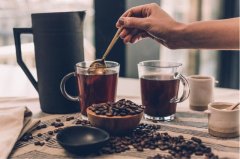Is the bean delicious in the manor? the planting and processing of the single bean in the manor

For professional baristas, please follow the coffee workshop (Wechat official account cafe_style)
Baking method: lower bean in the middle of one explosion, Oushe M0 baking degree (cinnamon roast), baking time 12 minutes,
Dry aroma: grease, manor chocolate, berries, cherries, flowers, sweet spices, clean and diverse aromas
Wet aroma: caramel, dark berry, grape, citrus
Sipping: clean and delicate, dark berries, raspberries, a variety of aromas, spices and ginger flowers, manor-grade delicate chocolate, various berry chocolates, citrus sweetness, Burgundy red wine, grapes, cream sugar, black cherries, sweet pineapples, flowers and spices sweet, black tea sweet, fruit juice sweet.
Nicaragua Nicaragua
Population: 6071000
Nicaragua has some smaller growing areas, including Madriz (Madriz), Managua (Managua), Boaca and Carazo (Carazo), which are not listed below but actually produce some excellent coffee.
JINOTEGA
The name of the Xenotegav region, as well as the name of its capital, comes from the word "xinotencatl" in Nahuatl, but opinions vary on the meaning of the word, either "urban elderly" or "Jinocuabos's neighbor", but the latter may be more accurate. The economy of the region has long been dependent on coffee and it remains the main producing area in Nicaragua.
Altitude: 1100-1700m
Harvest: December-March
Variety: Caturra, bourbon
MATAGALPA
Matagalpa, which is named after the capital city, has set up a coffee museum. Coffee in this area is produced by a mixture of large estates and cooperatives.
Altitude: 1000-1400m
Harvest: December-February
Variety: Caturra, bourbon
Nicaragua God-given Hope Manor 2010 Nicaragua Excellence Cup has won the Presidential Award. The output is not much, which is not a place visited by big buyers....
N regalo de Dios means-- (gift from God)-Nueva Segovia (New Sagovia producing area) is located at high altitude in the small town of Mozonte in Nepal, and the manor is headed by Luis Alberto Balladares Moncada.
In recent years, only about 30 coffee farms have been selected for the CoE competition in Nepal each year, and 80% of them come from Nueva Segovia (the new Sagovia producing area), which is planted at an altitude of about 1400 Murray 1700 meters. Although steep but rich in animal and plant ecology and beautiful mountain scenery and primitive forests and cold mountain springs, ecological conservation is very important, about 1350 meters to 1800 meters above sea level, clouds and clouds in the morning and evening, annual rainfall of about 1700 mm, the annual average temperature below 20 °C, therefore, the coffee flavor is rich and meticulous, the soil is sandy and limestone layer.
Pacamara is a rare and precious variety developed in El Salvador with rich / varied flavors, apricot / vanilla plants / tropical fruits / chocolate / sweet spices and other varieties. few coffee varieties can have bright acidity but strong sweetness, but it is the same problem as other large beans-relatively small yields.
Pacamara is a variety derived from elephant bean Maragogype and Pacas Pacas, which is composed of the first four letters of Maragogype and Pacas respectively. The grain size is similar to that of elephant bean (about 20 mesh on average). It is the best coffee variety in Central and South America.
The characteristics of coffee:
Name of the manor: Finca Un Regalo de Dios
Landowner: Luis Alberto Balladares Moncada
City: Mozonte
Production area: Nueva Segovia
Area: 301 ha
Altitude: 1700m
Variety: Pacamara. Moonstone
Treatment: full water washing, natural sun drying
Lemon aromas with carambola sweetness and a hint of mango sour. The palate has the sweetness of berries and the finish of apples.
Properties:
Dry / wet-peach / longan nectar / vanilla / floral / caramel / grape / chocolate / berry / citrus
Sipping-sweet / tropical fruit flavor / citrus sweet / peach / berry / flower aroma, good cleanliness, nuts / caramel / chocolate, obvious feeling of vitality, long-lasting sweetness of nectar, delicate finish of peach, strong nose aroma.
"God bless you, Patrick." Luis, the owner of Niagara's God-given Manor, is a devout Catholic, which can be seen in his words and deeds and his kindness to workers during his several days with him. He blessed the author because I announced on facebook that 50% of the proceeds from the sale of travel books would be donated to a local children's charity called Fundacion de Ninos Un Corazon para Amar.
The story of coffee beans before they were put into the bag
This is the first time that travel notes have been published on the subject of the upstream coffee industry. My aim is to enhance the downstream industry's understanding of the upstream industrial chain, and to enable the public to peep into the story before the coffee beans enter the bag through interview photography. As far as I know, this travel book is the world's first print album shot solely with a Leica monochrom camera. On this visit to Central America, I only used a 35mm lens nicknamed "Seven Jade." since the purpose of photography is not aesthetic appreciation, post-production is also based on the principle of narrating stories. I hope the photographers will forgive me.
Unwittingly, he has returned from a visit to the farm for three months. The work of the coffee shop in the city is the same: the layout remains the same, the air-conditioning is on, and colleagues silently participate in purchasing raw beans, baking, cooking, communicating with guests, and so on. The only thing that confirms the passage of time may be the special menu that changes with the season. Stepping into June, I believe that the coffee trees in the valley have returned to green from the fiery red full of fruit; after a period of time, the branches will be covered with snow-white flowers and fragrance everywhere. Of course, the scene in the eyes of farmers will not be so romantic, but working by relying on the laws of nature's four seasons is something that many urban people have never experienced in their poor lives.
In the long industrial chain, coffee has changed from a seed to a tree, from harvest to processing, and then from roasting to extraction, passing through the hands of countless "peers". This trip made me find that I am not only curious about the industrial chain, but also farmers want to know how their coffee will be interpreted and appreciated by consumers when they go to the other side of the world. For example, they know that the beans with the highest density are the best, that is, they sell at a good price, but they know nothing about the difference in taste between high-quality and poor-quality beans and how to bake them. I used a local sample roaster to demonstrate the roasting method of sun-treated coffee in our store. After tasting it, they sighed with surprise: "it turns out that the coffee we grow can taste like this." I promised to mail them a set of hand pots and funnels so that farmers could taste the taste of their own coffee.
Of course, they are not the only ones who are amazed. The author and the group members have seen that farmers skillfully make use of their geographical location and limited natural resources to give full play to the potential of the fruit. Especially for the small family-run farms, their meat beaters are covered with rust, the washing drains are next to the kitchen sewers, and there is no tap water when cleaning, but with barreled water! But it happens that most of the winners in national competitions are small farms. Perhaps enthusiasm and concentration are the secret recipe for quality.
Each farm has a different view of coffee, some hereditary, some Excelsior. They will use limited facilities to match the weather of the season to make moving works. And boutique coffee is most favored by defective beans. After we spent the whole morning screening only a few hundred grams of coffee, we realized that flawless is not taken for granted, which involves a lot of manpower and material resources and farmers' dedication and dignity to the products.
The best coffee shops around the world send people to visit the farm regularly. In addition to purchasing, it will also be used to explore market trends or explore new varieties. Seeing that many operators have regarded it as a routine of "picking goods", the author wants to open up his field of vision: every farm has its own story worth savoring.
Country: Nicaragua
Name of the manor: Finca Un Regalo de Dios
Landowner: Luis Alberto Balladares Moncada
Ranking: second Runner-up (2010 CoE National Competition)
City: Mozonte
Production area: Nueva Segovia
Manor area: 14.68 hectares
Altitude: 1750 m
Cultivated variety: Catuai Rojo,Maracaturra
Treatment: washing, scaffolding in the sun
Batch quantity: 42 cases
Total: 2746.05 (1245.59 kgs)
Final score: 91.31
Cup test code #: 293
Winning bidder: Orsir Coffee (Taiwan)
Cup test report:
Important Notice :
前街咖啡 FrontStreet Coffee has moved to new addredd:
FrontStreet Coffee Address: 315,Donghua East Road,GuangZhou
Tel:020 38364473
- Prev

How to deal with the processing of Hope Manor beans? how to divide the grades of Hope Manor beans?
For the exchange of professional baristas, please pay attention to the coffee workshop (Wechat official account cafe_style) Colombia hopes that the proportion of defective beans screened by hand is about 4%, the weight loss ratio of roasted to light roasted (city) coffee beans is 14%, and the proportion of empty shell beans to bad beans is 6%. When picking up defective beans with the fresh aroma of forage grass, such as walking on the grass after rain, raise the steaming temperature a little to compare.
- Next

The production area of single bean in Tianzhi Manor introduces how to brew single bean in Tianzhi Manor.
For professional baristas, please follow the coffee workshop (Wechat official account cafe_style) country: Nicaragua Manor name: Finca Un Regalo de Dios Manor name: Luis Alberto Balladares Moncada ranking: second Runner-up (2010 CoE National Competition) City: Mozonte producing area: Nueva Segovia Manor area: 14.68cm
Related
- Does Rose Summer choose Blue, Green or Red? Detailed explanation of Rose Summer Coffee plots and Classification in Panamanian Jade Manor
- What is the difference between the origin, producing area, processing plant, cooperative and manor of coffee beans?
- How fine does the espresso powder fit? how to grind the espresso?
- Sca coffee roasting degree color card coffee roasting degree 8 roasting color values what do you mean?
- The practice of lattes: how to make lattes at home
- Introduction to Indonesian Fine Coffee beans-- Java Coffee producing area of Indonesian Arabica Coffee
- How much will the flavor of light and medium roasted rose summer be expressed? What baking level is rose summer suitable for?
- Introduction to the characteristics of washing, sun-drying or wet-planing coffee commonly used in Mantenin, Indonesia
- Price characteristics of Arabica Coffee Bean Starbucks introduction to Manning Coffee Bean Taste producing area Variety Manor
- What is the authentic Yega flavor? What are the flavor characteristics of the really excellent Yejasuffi coffee beans?

